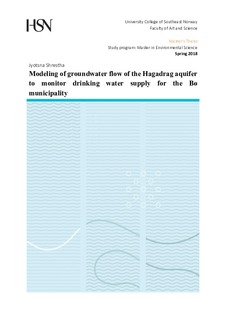| dc.description.abstract | Groundwater flow model is a numerical representation of the complex hydrological system into simple graphical form for simulation and prediction. The purpose of developing groundwater flow models vary from study to study and follows a sequential modeling approach. This study was designed to develop a groundwater flow model for Hagadrag aquifer situated in Bø and Seljord municipalities of the Telemark County in the southeastern part of Norway. The aim of the model development was to determine the flow pattern in the aquifer and capture zones of the pumping wells, thereby monitoring the groundwater for any possible contamination source. The numerical model was developed in Processing Modflow (PMWIN) using ArcMap as pre and post processor. The data required for the model development were extracted from national map data and fieldwork from previous studies. The use of ArcMap as a GIS tool to process the data for modeling and visualizing the model developed in PMWIN has been justified in this study. The model was calibrated using manual trial-and-error calibration. The calibrated parameters included riverbed conductance, precipitation and infiltration from injection wells. Among these, riverbed conductance was the most sensitive parameter. The calibration of the model was not only focused on quantitative measure of RMSE, but also on the appropriateness of the estimated parameter values that comply with the conceptual model. The simulations show that the location of a well in accordance to river bends and distance from river determines the flow pattern. The Bø river and Herretjønn are the major surface water resources infiltrating into the Hagadrag aquifer. However, the volume of water infiltrated from these surface water resources depend on the precipitation and volume of water extracted from the pumping wells. The findings from this study suggest that any contamination to the Bø river upstream and Herretjønn can be a big threat to the aquifer, thereby requiring continuous monitoring of these surface water resources. | nb_NO |
